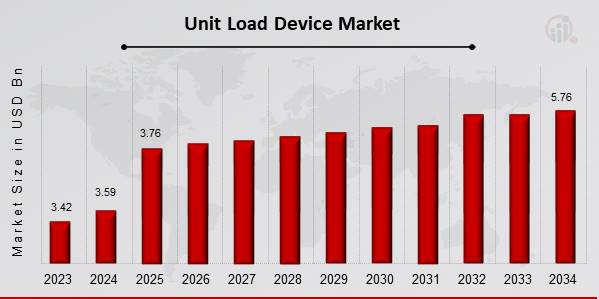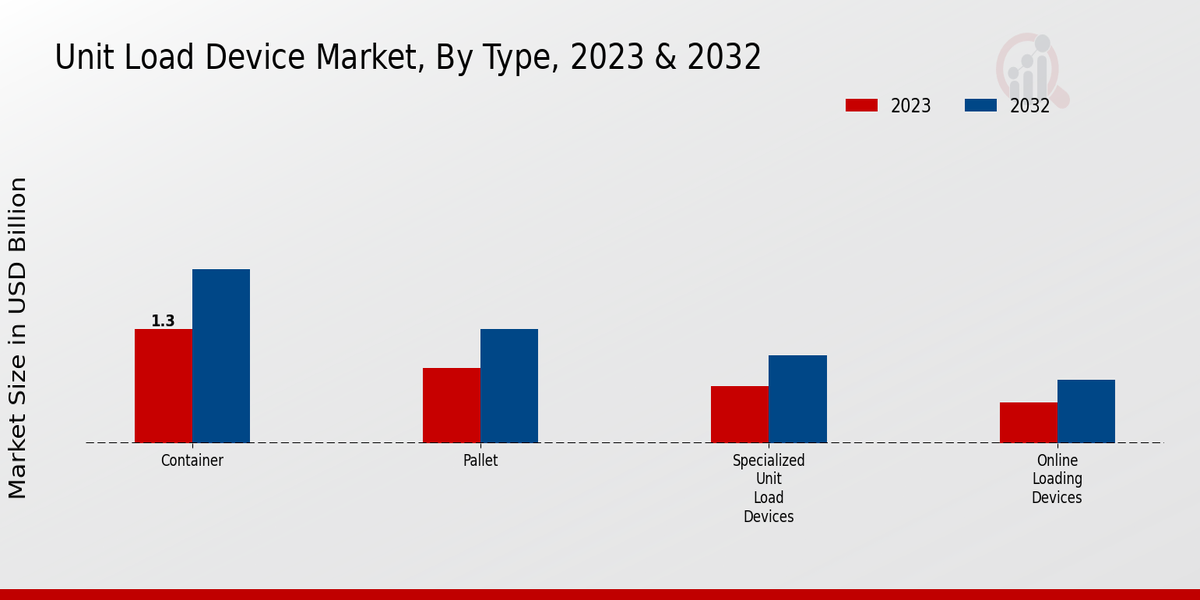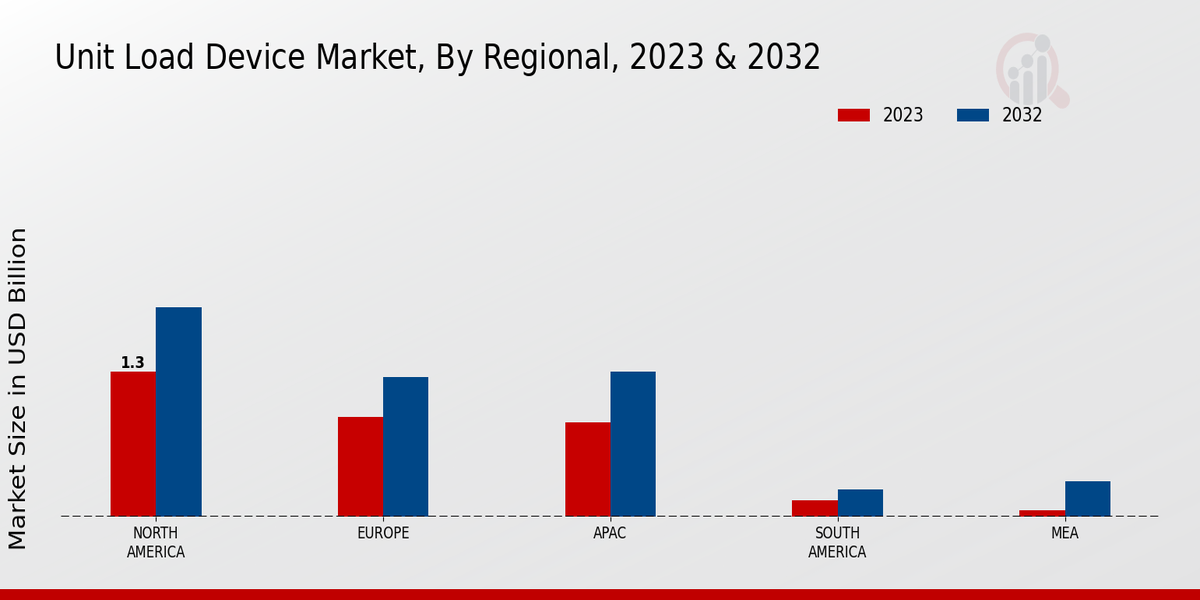Unit Load Device Market Overview
As per MRFR analysis, the Unit Load Device Market Size was estimated at 3.59 (USD Billion) in 2024. The Unit Load Device Market is expected to grow from 3.76 (USD Billion) in 2025 to 5.76 (USD Billion) by 2034. The Unit Load Device Market CAGR (growth rate) is expected to be around 4.90% during the forecast period (2025 – 2034).

Source: Primary Research, Secondary Research, MRFR Database and Analyst Review
Key Unit Load Device Market Trends Highlighted
The Global Unit Load Device Market is shaped by several key drivers. The rise in air cargo transportation is a significant factor as airlines and logistics companies seek efficient solutions for moving goods.
The increasing focus on optimizing supply chains also drives demand for standardized containers and pallets, which enhance loading efficiency and reduce costs. Additionally, the growing need for security and protection of goods during transit has led to innovations in unit load device designs, making them more durable and secure.
These factors collectively push the market towards greater growth and development. Opportunities in the market include advancements in materials technology, which can lead to lighter and stronger unit-load devices.
This can enhance fuel efficiency for airlines as lighter loads require less energy to transport, resulting in cost savings and reduced environmental impact. Moreover, the integration of smart technologies into unit load devices presents a noteworthy avenue for innovation.
This includes features like GPS tracking and temperature control, which can add value in specialized transportation like pharmaceuticals and perishables. As logistics operations become more digitized, these opportunities can help companies differentiate themselves in a competitive landscape.
Recent trends highlight a shift towards sustainability and eco-friendly solutions. Manufacturers are increasingly adopting recyclable and biodegradable materials for constructing unit load devices.
There is also a growing awareness surrounding the reduction of carbon footprints, motivating companies to invest in more sustainable practices. The ongoing COVID-19 pandemic has accelerated changes in e-commerce and online shopping, further boosting the need for efficient cargo transportation.
These trends have paved the way for enhanced product offerings and improvements in logistics operations, positioning the market for ongoing evolution in response to shifting demands and expectations.
Unit Load Device Market Drivers
Increasing Demand for Efficient Air Cargo Operations
The global landscape of air transport is evolving rapidly, and with it emerges a pressing need for efficient air cargo operations. This has become a driving factor for the Global Unit Load Device Market as airlines and logistics companies seek to optimize their processes and reduce operational costs.
The growing trend towards online shopping and the need for quick deliveries have heightened the demand for cargo transportation services, leading to a surge in the use of unit load devices (ULDs).
These devices play an essential role in ensuring that cargo is loaded, unloaded, and transported efficiently, minimizing time spent on the tarmac and reducing the potential for damage during transit. The increasing air cargo volumes due to globalization and increased e-commerce activities further fuel the demand for innovative ULD solutions that can accommodate various dimensions and weights of cargo.
Furthermore, the airlines are continuously looking for ULDs that are not only lightweight and durable but also cost-effective to maintain.
As sustainability becomes a focal point for many industries, ULD manufacturers are also innovating to produce eco-friendly units that align with airlines' green initiatives. This emphasis on efficiency, combined with the need for sustainability, directly contributes to the steady growth and future prospects within the Global Unit Load Device Market.
Technological Advancements in ULD Design
Technological advancements in the design and manufacturing of unit-load devices are crucial drivers within the Global Unit unit-load device Market. With the integration of materials that reduce weight yet enhance strength, ULDs are evolving to meet the changing demands of air freight logistics.
Innovations such as automated handling systems and smart ULDs equipped with tracking technologies are reshaping the dynamics of cargo management. These advancements enhance operational efficiency, reduce manual handling, and provide real-time tracking of shipments, directly benefiting both logistics providers and end customers.
Given the anticipated growth of air freight, the importance of leveraging technology to streamline operations cannot be overstated.
Regulatory Changes Favoring Air Transport
Regulatory changes that favor the air transport sector significantly impact the Global Unit Load Device Market. Governments around the world are implementing policies aimed at improving air travel efficiencies and reducing bottlenecks in cargo handling.
These regulations often emphasize safety standards, environmental considerations, and enhanced logistical efficiencies, thereby directly influencing the adoption of unit load devices. As air transport becomes a preferred choice for time-sensitive and delicate goods, the alignment of government regulations with industry needs will continue to drive growth in the ULD market.
Unit Load Device Market Segment Insights
Unit Load Device Market Type Insights
The Global Unit Load Device Market exhibits a robust growth trajectory, driven significantly by its various types, which include containers, pallets, specialized unit load devices, and online loading devices.
Among these types, the container segment held a dominant position with a valuation of 1.3 USD Billion in 2023 and is expected to reach 1.98 USD Billion by 2032, showcasing its majority holding within the market.
This prominence can be attributed to the essential role containers play in securely storing and transporting goods across different modes of transportation, thereby enhancing supply chain efficiency. Following the container segment, the pallet segment had also shown significant growth, valued at 0.85 USD Billion in 2023, projected to grow to 1.3 USD Billion by 2032.
Pallets are crucial in various industries, providing ease of stacking and movement, which contributes to their significance in the overall market. On the other hand, specialized unit load devices, valued at 0.65 USD Billion in 2023, are gaining traction due to their tailored functionality for unique cargo requirements, reaching 1.0 USD Billion by 2032.
This segment's importance is reflected in the increasing demand for customized solutions that meet specific logistics challenges. Lastly, online loading devices, although valued lower at 0.46 USD Billion in 2023, are projected to grow to 0.72 USD Billion by 2032.
Their emergence can be attributed to the expanding trend of e-commerce, requiring more sophisticated and adaptive loading solutions to facilitate swift and efficient deliveries.
Overall, the Global Unit Load Device Market segmentation highlights the vital role that each type plays in shaping the market landscape, with particular emphasis on containers and pallets due to their capacity to meet the evolving demands of the industry.
These figures underline key trends, growth drivers, and the potential for future opportunities in the market, reinforcing the significance of understanding the dynamics within these categories for strategic planning and investment in the Global Unit Load Device Market.

Source: Primary Research, Secondary Research, MRFR Database and Analyst Review
Unit Load Device Market Material Insights
Aluminum dominates this segment due to its lightweight, durability, and resistance to corrosion, making it ideal for the aviation and logistics sectors. Plastic materials are also significantly prevalent, offering versatility and cost-effectiveness for various applications, which drives their demand in the market.
Wood is often used for its availability and ease of manufacturing, appealing to environmentally conscious solutions, whereas Composite Materials, known for their strength-to-weight ratios, present opportunities for innovation in developing enhanced load-bearing capacities.
The dynamics of Global Unit Load Device Market revenue are shaped by these materials, reflecting the critical role they play in optimizing storage, transportation, and logistics operations globally.
Continuous advancements and shifting market preferences in these materials reflect the evolving landscape of the Global Unit Load Device Market, enhancing its growth potential and addressing environmental concerns.
Unit Load Device Market Application Insights
Within this market, the significance of the Aviation sector is pronounced, contributing to efficiency in cargo transport and enabling airlines to optimize their operations. Logistics and Warehousing similarly play vital roles, with technology advancements bolstering the need for effective load management solutions to streamline processes in supply chains.
Shipping also remains a major player, as the demand for reliable and durable unit load devices rises with global trade expansion.
As the Global Unit Load Device Market revenue grows and the industry adapts to changing market dynamics, these applications are crucial in addressing emerging logistics challenges and capturing new opportunities within the market.
The data from the Global Unit Load Device Market statistics illustrates a robust interdependence among these applications, collectively driving market growth and innovation while ensuring that businesses can efficiently manage their transportation needs.
Unit Load Device Market End Use Insights
The segment includes key areas such as Commercial, Industrial, and Military applications, each playing a pivotal role in driving market growth. The Commercial sector is particularly significant, as businesses increasingly adopt unit load devices to enhance logistics efficiency and reduce transport costs.
Industrial usage remains critical as well, with manufacturers recognizing the benefits of streamlined operations and improved safety protocols utilizing these devices.
The Military segment emphasizes ruggedness and reliability, highlighting its importance in defense logistics, where secure transport of equipment is paramount.
As trends shift towards automation and improved cargo handling solutions, these end-use sectors are expected to thrive, influencing the broader Global Unit Load Device Market revenue. Overall, the segmentation portrays a dynamic landscape where demand is propelled by operational efficiencies and strategic logistical improvements across various industries.
Unit Load Device Market Regional Insights
North America dominated this market, holding a valuation of 1.3 USD Billion, which signifies its major role in the industry, driven by the presence of a robust logistics network and demand for air freight services. Europe followed with a significant valuation of 0.9 USD Billion, benefiting from stringent regulations and advancements in aerospace technology.
The APAC region, valued at 0.85 USD Billion, is experiencing rapid growth due to increasing air traffic and rising e-commerce activities, contributing to its substantial market share.
In contrast, South America and MEA held smaller valuations of 0.15 USD Billion and 0.06 USD Billion respectively, reflecting their emerging market status with potential for growth. However, MEA is projected to experience the highest growth rate, reaching 0.32 USD Billion by 2032, as investments in logistics infrastructure improve.
Overall, the Global Unit Load Device Market segmentation illustrates varying strengths and growth opportunities across regions influenced by economic conditions and infrastructural developments.

Source: Primary Research, Secondary Research, MRFR Database and Analyst Review
Unit Load Device Market Key Players and Competitive Insights
The Global Unit Load Device Market is characterized by a dynamic landscape driven by increased demand for efficient air cargo transportation and the ongoing expansion of the logistics sector. This market comprises various players that supply unit load devices, which are essential for improving the efficiency and safety of cargo handling in the airline industry.
As airlines seek to optimize space utilization and enhance operational capabilities, the market has seen significant investments in the development of lightweight, durable, and innovative designs. Advancements in materials technology, coupled with the rising awareness of sustainable practices, have led to the emergence of more environmentally friendly unit load devices.
Competitive strategies among market participants include strategic partnerships, mergers and acquisitions, and the introduction of advanced products tailored to meet the evolving needs of air cargo operators.
All Nippon Airways has established a strong presence in the Global Unit Load Device Market by leveraging its extensive experience in cargo handling and logistics management. The airline's commitment to quality and operational excellence has translated into a robust capability to provide customized unit load devices that cater to diverse cargo needs.
With a focus on technological integration, All Nippon Airways has adopted innovative tracking systems that enhance cargo visibility and facilitate better inventory management. Furthermore, its extensive network of domestic and international routes offers a competitive advantage, enabling the airline to efficiently transport unit load devices along with their cargo.
The strategic utilization of lightweight materials in their unit load devices underscores All Nippon Airways' dedication to improving fuel efficiency and reducing transportation costs, solidifying its position as a reliable player in this market.
Buro Happold, while primarily known for its engineering services, also plays a significant role in the Global Unit Load Device Market through its consultancy services aimed at optimizing cargo systems for airlines. The company offers expertise in designing and implementing efficient unit load device systems that enhance cargo flow and maximize the use of available space within aircraft.
Buro Happold’s strength lies in its ability to analyze operational challenges faced by airlines and provide tailored solutions that improve efficiency. By specializing in sustainable design practices, Buro Happold contributes to the development of environmentally friendly unit load devices, aligning with industry trends focused on sustainability.
The firm’s collaborative approach with airline operators ensures that their solutions are practical and effective, establishing Buro Happold as a valued partner in the optimization of unit load devices in the air cargo domain.
Key Companies in the Unit Load Device Market Include
Unit Load Device Market Developments
Recent developments in the Global Unit Load Device Market reflect significant growth and strategic shifts among key players. All Nippon Airways is focusing on enhancing its ULD fleet to increase operational efficiency.
Zodiac Aerospace continues to innovate with lightweight materials for unit load devices, aiming to improve fuel efficiency for airlines. In a notable move, Envirotainer has expanded its services by acquiring new technology to enhance the security and efficiency of its cool chain containers, addressing the increasing demand for temperature-sensitive cargo shipment.
Additionally, Collins Aerospace is strengthening its market position through collaborations aimed at sustainability initiatives in ULD designs. UPS has also announced investments in modernizing its ULD inventory as part of its larger strategy to improve logistics solutions amid growing e-commerce demands.
Recent reports indicate that Jettainer is performing well in the market due to an increased emphasis on cargo handling efficiency. The continued evolution of alliances and acquisitions within companies such as Boeing and SATS suggests that the market is becoming more competitive.
The overall valuation of companies within this sector is on an upward trend, significantly impacting operational capabilities and market dynamics.
Unit Load Device Market Segmentation Insights
-
Unit Load Device Market Type Outlook
-
Unit Load Device Market Material Outlook
-
Aluminum
-
Plastic
-
Wood
-
Composite Material
-
Unit Load Device Market Application Outlook
-
Aviation
-
Logistics
-
Warehousing
-
Shipping
-
Unit Load Device Market End Use Outlook
-
Commercial
-
Industrial
-
Military
-
Unit Load Device Market Regional Outlook
-
North America
-
Europe
-
South America
-
Asia Pacific
-
Middle East and Africa
| Report Attribute/Metric |
Details |
| Market Size 2024 |
3.59(USD Billion) |
| Market Size 2025 |
3.76(USD Billion) |
| Market Size 2034 |
5.76(USD Billion) |
| Compound Annual Growth Rate (CAGR) |
4.90% (2025 - 2034) |
| Report Coverage |
Revenue Forecast, Competitive Landscape, Growth Factors, and Trends |
| Base Year |
2024 |
| Market Forecast Period |
2025 - 2034 |
| Historical Data |
2021 - 2024 |
| Market Forecast Units |
USD Billion |
| Key Companies Profiled |
All Nippon Airways, Buro Happold, Envirotainer, Zodiac Aerospace, SmartKargo, Aircraft Container Leasing, Tokyo International Air Terminal, AeroTrans, Taghleef Industries, Collins Aerospace, Jettainer, United Parcel Service, Boeing, SATS, Hawaiian Airlines |
| Segments Covered |
Type, Material, Application, End Use, Regional |
| Key Market Opportunities |
Rising demand for air freight, Growth in e-commerce logistics, Adoption of lightweight materials, Expansion of airport infrastructure, and Innovations in IoT integration |
| Key Market Dynamics |
Growing air cargo demand, advancement in ULD technology, stringent safety regulations, rising e-commerce logistics, and increasing sustainability initiatives |
| Countries Covered |
North America, Europe, APAC, South America, MEA |
Frequently Asked Questions (FAQ) :
The Global Unit Load Device Market is expected to be valued at 5.76 USD Billion by 2034.
The Global Unit Load Device Market is projected to grow at a CAGR of 4.90% from 2025 to 2034.
North America held the largest market share in the Global Unit Load Device Market, valued at 1.3 USD Billion in 2023.
The Container type segment was valued at 1.3 USD Billion in 2023 and is expected to reach 1.98 USD Billion by 2032.
Key players in the Global Unit Load Device Market include All Nippon Airways, Envirotainer, Zodiac Aerospace, and Boeing.
The Pallet type segment is expected to be valued at 1.3 USD Billion by 2034.
The APAC region is expected to grow from 0.85 USD Billion in 2024 to 1.3 USD Billion by 2034.
Specialized Unit Load Devices are valued at 0.65 USD Billion in 2024 and are expected to reach 1.0 USD Billion by 2034.
Emerging trends and challenges are creating new growth opportunities within the Global Unit Load Device Market.
The Online Loading Devices segment is expected to be valued at 0.72 USD Billion by 2034.

















